Handgun Calibers: Complete Guide for Pistols and Revolvers
The best handgun caliber is an endlessly debated topic at gun ranges and online forums. The truth is, however, there are many viable options each with their strengths and weaknesses.
Below, we’ll explore the most popular revolver and pistol calibers to help you compare them and choose what’s best for your needs and abilities.
Caliber Meaning
Really quickly, let’s cover what a “Caliber” is.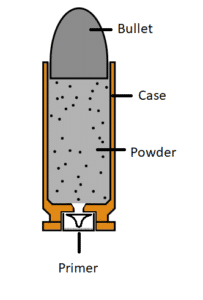
Caliber is a measurement of a bullet’s diameter. It can be measured in both inches and millimeters (mm). For example, .45 ACP has a diameter of 0.451 inches and 9mm has a diameter of 9.01 mm.
This can sometimes be confusing to newbies because without knowing this, you might assume 9mm is larger than something referred to as “Forty-Five A.C.P.” The reality, however, is that .45 ACP has a diameter more than 2.5mm greater than 9mm.
Though rarely labeled correctly in movies, television, or media, a “bullet” specifically refers to the metal projectile. The entire round is referred to as a “cartridge.”
To be clear, caliber refers specifically to the diameter of the bullet, not the case/casing that holds the bullet, powder, and primer.
If you’re buying ammunition to shoot at your local range, you can say “I want to buy a box of 9 millimeter ammo” rather than “9mm bullets” to be precise. With that said, gun shop employees are familiar with the misuse of “bullets” and will be able to help you figure out what you want to buy.
Popular Handgun Calibers
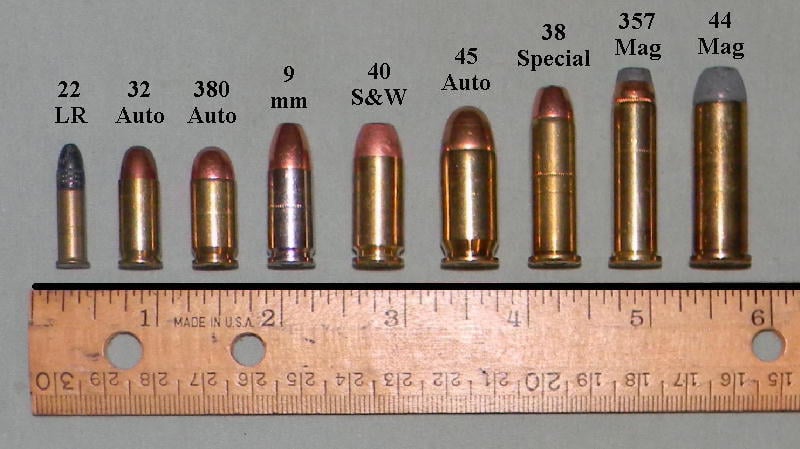
Though there are hundreds of different handgun cartridges that have been used in the past and continue to be used presently, the list you’re most likely to come across and choose is much shorter.
Today’s most popular handgun calibers are:
- .22 Long Rifle (.22 LR)
- .380 ACP (.380 Auto)
- 9mm (9x19mm Parabellum, 9mm NATO, 9mm Luger)
- .40 Smith & Wesson (.45 S&W)
- .45 ACP (.45 Auto)
- .38 Special
- .357 Magnum
- .44 Magnum
The table below shows the common velocity range, common energy range, common bullet weights in grains (gr), and a rough price range for bulk brass cased ammo for each caliber:
| Caliber | Velocity Range | Energy Range | Bullet Weights | FMJ Price Per Round |
|---|---|---|---|---|
| .22 LR | 1080-1280 fps | 104-146 ft.lb | 36 gr, 40 gr | $0.04-$0.07 |
| .380 ACP | 945-1150 fps | 185-203 | 90 gr, 95 gr | $0.24-0.40 |
| 9mm | 950-1200 fps | 295-384 ft.lb | 115 gr, 124 gr, 135 gr, 147 gr | $0.17-$0.25 |
| .40 S&W | 900-1200 | 358-496 ft.lb | 155 gr, 165 gr, 180 gr | $0.24-$0.32 |
| .45 ACP | 830-1015 fps | 333-423 ft.lb | 185 gr, 230 gr | $0.28-0.34 |
| .38 Special | 760-950 fps | 180-284 ft.lb | 110 gr, 125 gr, 130 gr, 158 gr | $0.27-0.38 |
| .357 Magnum | 1200-1500 fps | 505-759 ft.lb | 125 gr, 158 gr | $0.35-$0.64 |
| .44 Magnum | 1180-1750 fps | 742-1224 ft.lb | 180 gr, 200 gr, 240 gr, 300 gr | $0.56+ |
Though these are the most popular calibers, options like .32 ACP, .357 SIG, .45 GAP, and 10mm are also fairly commonly used.
What to Consider When Choosing a Handgun Caliber
Before getting into each specific revolver and pistol caliber, here’s some information that’s useful for making a decision.
Rimfire vs Centerfire
“Rimfire” refers to ammunition that’s primer is ignited by the firing pin crushing the base’s rim. This requires cases to be especially thin, limiting rimfire cartridges to low-pressure loads.
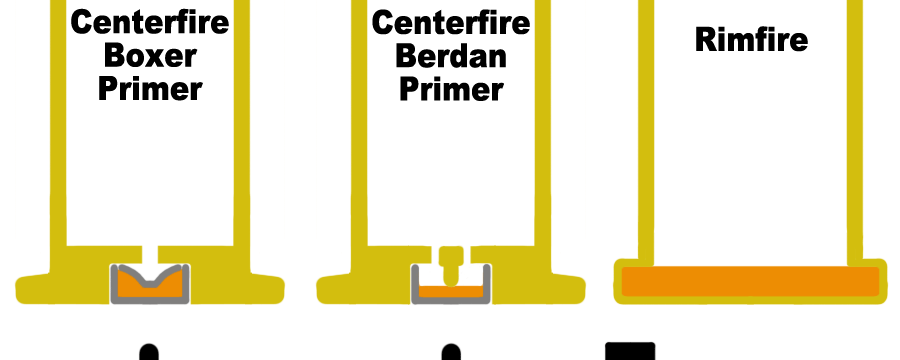
.22 Long Rifle is the only rimfire cartridge of the calibers we listed above. The rest of the calibers we mentioned are “centerfire,” meaning they have a primer located at the center of the case head.
While rimfire ammunition is cheaper to produce, it is less reliable than centerfire ammunition. This is another reason .22 LR is not recommended for self-defense.
Performance and Recoil
Bullet weight (measured in grains (gr)) and bullet velocity (measured in feet per second (fps)) play a big part in the energy inflicted on your target, but larger and/or faster bullets also create more energy you feel in terms of recoil. This is especially true in lighter handguns, as heavier handguns soak up more felt recoil.
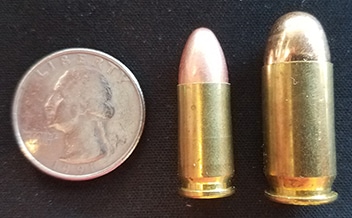
In theory, a caliber with heavy and very fast bullets sounds optimal, but in reality, it can have significant negative impacts on your ability to handle shooting it. Greater felt recoil can lead to worse accuracy and a long time getting back on target between shots.
Put simply, the ballistic performance of a given caliber doesn’t matter if you can’t hit your target with it.
Accuracy and speed were a primary factor in the FBI switching from .40 S&W to 9mm.
The Ballistic Research Facility has conducted a test which compares similar sized Glock pistols in both .40 S&W and 9mm calibers, to determine if more accurate and faster hits are achievable with one versus the other. To date, the majority of the study participants have shot more quickly and more accurately with 9mm caliber Glock pistols. The 9mm provides struggling shooters the best chance of success while improving the speed and accuracy of the most skilled shooters.
Ballistic Performance
The best way to compare the performance of different calibers and different ammunition loads within the same caliber for self-defense is ballistic gel tests. Ballistic gel is used as a replacement for living tissue as a standardized testing method.
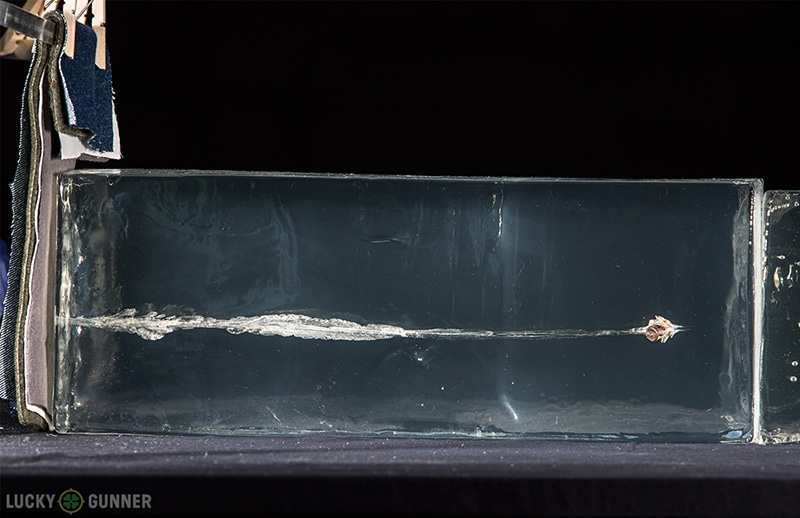
In ballistic gel tests, the FBI recommends bullet penetration in the range of 12-18 inches and has even determined it to be “The single most important factor in effectively wounding a human target.” Less than 12 inches runs the risk of projectiles coming short of vital organs, whereas more than 18 inches of penetration is likely to go through your target and risk hitting innocent bystanders.
There are two primary types of bullets, full metal jacket and hollow point bullets.
Full metal jacket (FMJ) bullets have a soft core wholly encased in harder metal.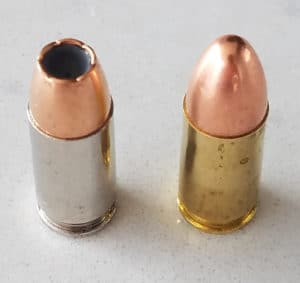
As the name suggests, hollow point (HP, JHP, etc.) bullets are hollow at the tip of the projectile. They are designed to expand upon impacting a target. This expansion increases the diameter of the projectile as it passes through your target, thus inflicting damage over a greater area.
Hollow point bullets are recommended for self-defense, whereas cheaper FMJ ammunition can be used for target shooting and practice.
Along with penetration, expanded diameter is one of the most crucial factors in determining the “stopping power” of a given bullet.
Ammunition retailer Lucky Gunner has done extensive ballistic gel testing based on the FBI testing procedure. The best performing 9mm loads achieve an expanded diameter of 0.69”-0.74”, whereas the best .40 S&W loads expand to 0.7-0.82”. The expanded diameter of the best .45 ACP loads can reach as great as 1.0”, though this is more of an outlier than what’s normal.
Based on the FBI’s testing, they determined:
-
9mm Luger now offers select projectiles which are, under identical testing conditions, I outperforming most of the premium line .40 S&W and .45 Auto projectiles tested by the FBI
-
There is little to no noticeable difference in the wound tracks between premium line law Auto enforcement projectiles from 9mm Luger through the .45 Auto”
Your Shooting Ability
As stated above, the FBI has found that most of their study participants performed better with 9mm than larger calibers. With modern hollow points reducing the gap in terms of penetration and bullet diameter (once expanded), most people are probably better off opting for 9mm for self-defense.
With that said, if you’re able to maintain speed and accuracy with .40 S&W or .45 ACP, it’s certainly worth considering these calibers for self-defense. See how larger calibers feel when practicing at the range and even consider testing your time/split times for various shooting drills with a shot timer.
Magazine Capacity
Larger bullets and cartridges, unfortunately, mean fewer rounds can fit in similarly sized magazines. For example, the 9mm Glock 17 has a magazine capacity of 17 rounds, whereas the comparable .45 ACP Glock 21 holds just 13 rounds.
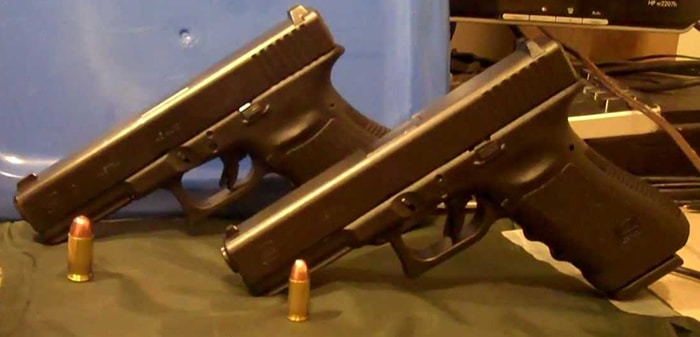
Remember, it’s entirely possible it could take multiple shots to neutralize an attacker and there’s a good chance you’ll miss some shots in a high-pressure situation.
The differences in magazine capacity can be even more meaningful when comparing compact and subcompact pistols.
Cost
I’d always recommend opting for the best hollow point ammo for self-defense, but I tend to buy the cheapest brass cased FMJ for practice. The difference between 9mm and less common calibers can, however, still be significant when buying the most inexpensive available practice ammo. You don’t want the price of ammo to stop you from training.
If you’re just looking to shoot as a hobby, .22 LR will save you huge amounts compared to any other caliber.
Purpose
The most important thing to consider when choosing a caliber is what you need from it. While there are a variety of calibers sufficient for self-defense against human attackers, they’re probably not optimal if your hiking and want to protect yourself from large animals.
Making sure a caliber is sufficiently powerful for your needs supersedes other criteria to consider. If you’re not capable of accurately shooting a large caliber that you want to use for bear defense, your only option is to get more comfortable with shooting that handgun.
Handgun Calibers
With that out of the way, here’s what you need to know about all the most popular handgun calibers. I’ll also give some general advice, just in case you are new to firearms.
.22 Long Rifle (.22 LR)
Though it’s not the best choice for self-defense, .22 Long Rifle has been a favorite caliber among gun owners since its creation in 1884. Today, it’s most used for shooting recreationally without breaking the bank.
There are many firearms chambered in .22 LR including pistols, revolvers, and rifles. With what feels like essentially no recoil, .22 LR firearms are great for introducing new, young, weak, or disabled people to shooting.
When I’m bringing a friend or family member to shoot for the first time, I generally start them on a .22 rifle, followed by a .22 pistol before moving onto larger caliber firearms.
Because .22 ammo is so cheap, it’s also become a favorite option among preppers and survivalist. You can commonly find deals to stock up on 5,000 rounds for under $200. Though it’s under-powered to be considered optimal for most purposes, it might be able to get the job done for a variety of tasks post-apocalypse… or less extreme circumstances.
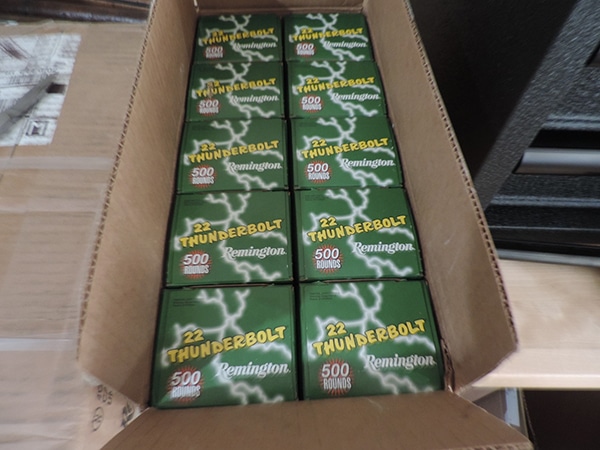
.22 Long Rifle Stats:
- Typical Velocity Range: 1080-1280 fps
- Typical Energy Range: 104-146 ft.lb
- Common Bullet Weights: 36 grain, 40 grain
- Bulk FMJ Ammo Price: $0.04-$0.07 per round
.380 ACP (.380 Auto)
There are handgun calibers between .22 Long Rifle and .380 ACP, but they’re generally not too popular. They they serve limited purposes and are far more costly than .22 LR.
.380 Automatic Colt Pistol (ACP) was one of the many calibers created by legendary firearms designer John Browning, dating back to 1908.
It’s on the edge of what I’d consider using for self-defense, but I’d recommend trying to move up to 9mm if possible. Ballistic tests performed by Lucky Gunner show that few .380 loads hit the sweet spot in terms of bullet penetration, with many failing to reach the 12″ minimum. Loads that did hit the bullet penetration sweet spot often had a poor expanded diameter.
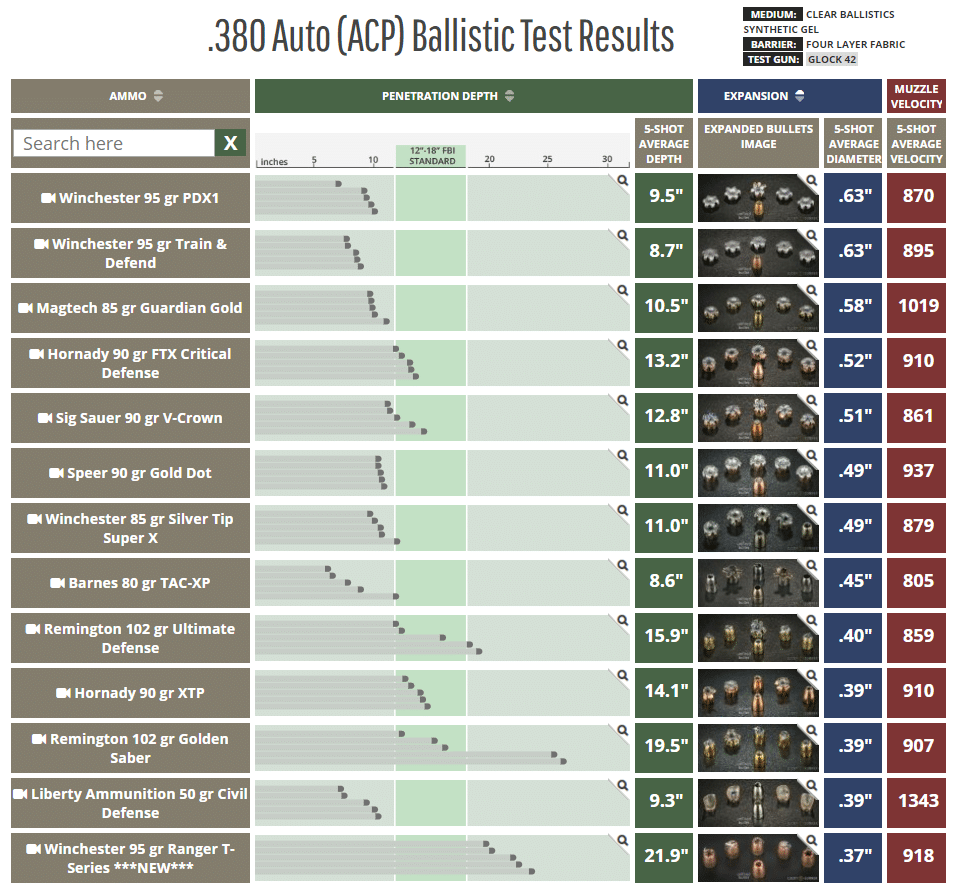
As far as positives, .380 ACP does have a few strong ones. For starters, pretty much all non-disabled adult shooters should easily be able to handle it.
Those of you looking for a subcompact pistol will also be able to find a legitimate “pocket pistol” chambered in this caliber if you want. I’ve met a lot of women who concealed carry pistols like these since it’s harder for smaller framed people to conceal a firearm.
.380 ACP Stats:
- Typical Velocity Range: 945-1150 fps
- Typical Energy Range: 185-203 ft.lb
- Common Bullet Weights: 90 grain, 95 grain
- Bulk Brass Cased FMJ Ammo Price: $0.24-$0.40 per round
- Max Bullet Expansion: 0.63″ (in Lucky Gunner Tests)
9mm
9mm is my favorite pistol caliber and it’s the most popular used for self-defense. It hits the sweet spots in terms of strong performance and limited recoil. Likely because it’s so popular, ammo is generally cheapest for 9mm compared to other self-defense calibers.
Though it may feel like a bit much to brand new shooters, the vast majority of people should be able to handle shooting a pistol chambered in 9mm with some practice. In my experience, all of my male friends had no issues learning to shoot 9mm handguns with reasonable accuracy within 10 yards on their first day.
As I mentioned above, the FBI and many police departments have switched to 9mm as the majority of shooters perform better with it than larger pistol calibers. Modern technology has also reduced the gap in maximum expanded diameter between 9mm and larger calibers.
If you’re buying your first pistol for self-defense or just looking to buy your first handgun, 9mm is a great place to start. You can find full-size pistols or even ultra-compact pistols like the SIG Sauer P365 chambered in 9mm.
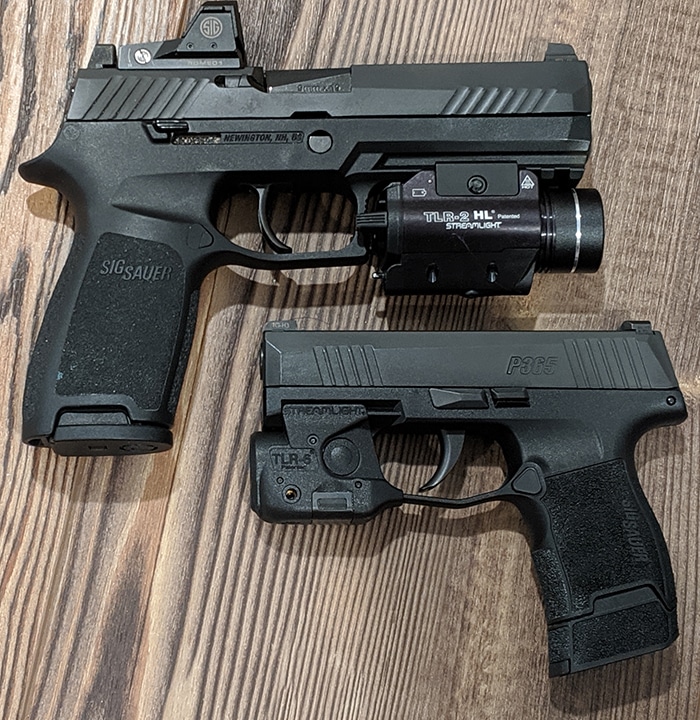
9mm Stats:
- Typical Velocity Range: 950-1200 fps
- Typical Energy Range: 295-384 ft.lb
- Common Bullet Weights: 115 grain, 124 grain. 135 grain, 147 grain
- Bulk Brass Cased FMJ Ammo Price: $0.17-$0.25 per round
- Max Bullet Expansion: 0.74″ (in Lucky Gunner Tests)
.40 S&W
.40 S&W has been a popular pistol caliber among law enforcement since it was designed in 1990. In fact, it was designed based on the FBI’s demands.
Severely outgunned, two FBI special agents were killed and five were wounded in the 1986 FBI Miami Shootout. This lead the Bureau looking to switch from .38 Special revolvers to pistols for greater magazine capacity.
They began testing various calibers, including 9mm and .45 ACP but were most impressed by the performance of handloaded 10mm loads made personally by the FBI Firearms Training Unit’s special agent-in-charge John Hall. Smith & Wesson was enlisted to design a new caliber meeting the FBI’s specifications and in doing so, they discovered that they could shorten the 10mm case enough to fit within their medium-framed 9mm handguns. Smith & Wesson then joined forces with ammunition manufacturer Winchester to begin producing the new .40 S&W ammunition.
.40 S&W ammunition typically has around the same velocity as 9mm loads, despite the bullets being heavier.
Mass and velocity are the factors that determine a bullet’s kinetic energy. With .40 S&W loads having a much faster velocity than .45 ACP and a bullet mass heavier than 9mm, .40 S&W can sometimes produce the most kinetic energy of the group. It can also rival .45 ACP in terms of recoil energy, especially because .40 S&W chambered pistols tend to be lighter than those chambered in .45 ACP.
Though the recoil difference between .40 S&W and 9mm is definitely noticeable, most people shouldn’t have too much trouble getting comfortable shooting the larger caliber. The real question, however, is whether you can perform as well shooting it when time and accuracy are a factor.
.40 S&W Stats:
- Typical Velocity Range: 900-1200 fps
- Typical Energy Range: 358-496 ft.lb
- Common Bullet Weights: 155 grain, 165 grain. 180 grain
- Bulk Brass Cased FMJ Ammo Price: $0.24-$0.32 per round
- Max Bullet Expansion: 0.82″ (in Lucky Gunner Tests)
.45 ACP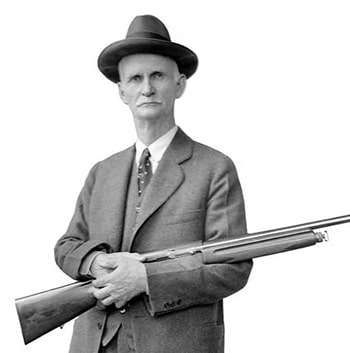
.45 ACP is an American classic and another caliber designed by John Browning. Browning began working on it in 1904 for use in testing what would become the M1911 pistol. After successful military trials, the 1911 replaced the various revolvers that were in service and it was the standard-issue sidearm for the United States military from 1911-1986.
Today, the 1911 and .45 ACP still have a ton of fans in the firearms community. Nearly every serious gun collector seems to own at least one 1911. If 1911s aren’t your thing, all major pistol manufacturers have offerings chambered in .45 ACP.
Though .45 ACP can produce a lot of energy, you may actually be surprised how manageable it is shooting from a heavy 1911. With that said, it’s less manageable for some shooters out of modern polymer-framed pistols.
My thoughts on .45 ACP for self-defense are similar to .40 S&W. If you can handle it and feel you perform well, then go for it, but you’re likely to find at least small drops in your performance with it compared to 9mm.
One major benefit to .45 ACP’s low velocity is that it’s an ideal candidate for suppressed shooting. Suppressors (also referred to as “Silencers”) are NFA items, meaning you have to deal with the Bureau of Alcohol, Tobacco, Firearms and Explosives to purchase one. If you’re fine waiting months or even longer than a year, plus paying a $200 tax stamp to obtain a suppressor, you should strongly consider .45 ACP.

.45 ACP Stats:
- Typical Velocity Range: 830-1015 fps
- Typical Energy Range: 333-423 ft.lb
- Common Bullet Weights: 185 grain, 230 grain
- Bulk Brass Cased FMJ Ammo Price: $0.28-$0.34 per round
- Max Bullet Expansion: 1.00″ (in Lucky Gunner Tests)
.38 Special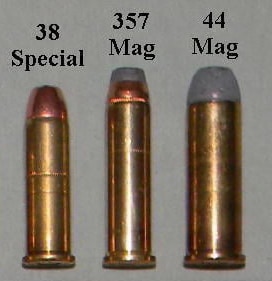
.38 Special is a revolver caliber that was commonly used by police until the 90s. As mentioned in our section on .40 S&W, the FBI ditched their revolvers chambered in .38 Special for the increased capacity offered by semi-automatic pistols.
You may find that you enjoy shooting revolvers, but I’d personally avoid this caliber for anything serious in favor of a pistol caliber and pistol. The magazine capacity and performance of 9mm or larger pistol calibers should make this a no-brainer.
As is clear by this point, I’m not a fan of revolvers, but the manageable recoil of .38 Special does make it a reasonable choice for introducing new shooters to firearms.
.38 Special Stats:
- Typical Velocity Range: 760-950 fps
- Typical Energy Range: 333-423 ft.lb
- Common Bullet Weights: 110 grain, 125 grain, 130 grain, 158 grain
- Bulk Brass Cased FMJ Ammo Price: $0.27-$0.38 per round
- Max Bullet Expansion: 0.73″ (in Lucky Gunner Tests)
.357 Magnum
.357 Magnum is the first caliber on this list that can start to be no fun to shoot, particularly with small revolvers. As you’ll see in the stats below, there’s a big jump in its velocity and energy compared to other calibers.
You can also shoot .38 Special in .357 Magnum revolvers, but you can NOT shoot .357 in a revolver designed for .38. Since .38 Special can be significantly cheaper than .357, many people shoot it at the range from .357 revolvers.
As is the case with all revolvers, capacity is an issue, but .357 Magnum starts to pack enough punch for protection against large animals.

.357 Magnum Stats:
- Typical Velocity Range: 1200-1500 fps
- Typical Energy Range: 505-759 ft.lb
- Common Bullet Weights: 125 grain, 158 grain
- Bulk Brass Cased FMJ Ammo Price: $0.35-$0.64 per round
- Max Bullet Expansion: 0.75″ (in Lucky Gunner Tests)
.44 Magnum
At the risk of catching heat for this from you readers, .44 Magnum is the first caliber on this list that I don’t particularly enjoy shooting. The recoil of .44 Mag is enough that I don’t want to be shooting it all day at the range.
It is, however, the first revolver caliber that I’d seriously consider using for defense against animals like bears. AmmoLand found 12 reported cases of people using .44 Mag to protect themselves from bears, all of which were successful. It was also the most common caliber used in defending bear attacks.
.44 Magnum Stats:
- Typical Velocity Range: 1180-1750 fps
- Typical Energy Range: 742-1224 ft.lb
- Common Bullet Weights: 180 grain, 200 grain, 240 grain, 300 grain
- Bulk Brass Cased FMJ Ammo Price: $0.56+ per round
Even Larger Calibers
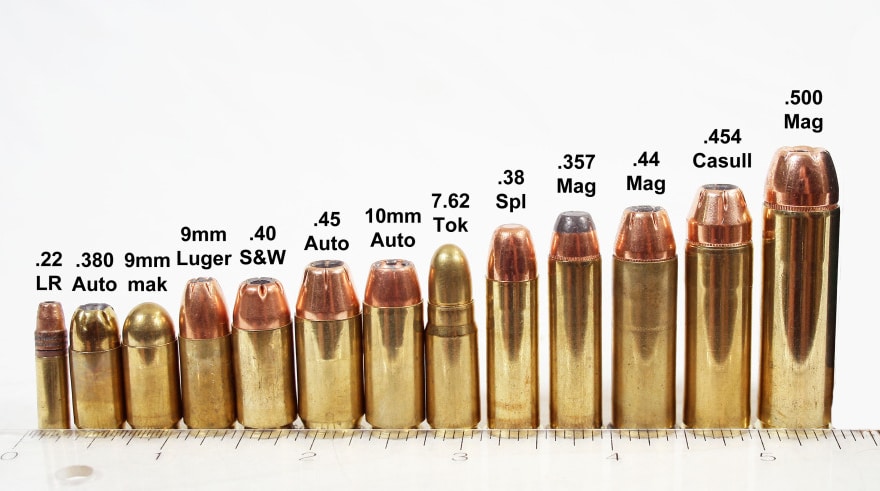
For protection against bears or just attempting to look cool at the range, there are handgun calibers even more powerful than .44 Magnum.
.454 Casull, .50 AE, and .500 Magnum are all options if you hate your hands and your wallet. .500 Magnum can pack well over 2,000 ft.lb of muzzle energy.
Conclusion
That wraps up our list of the most popular handgun calibers.
For most people buying their first handgun for target shooting and self-defense, you generally can’t go wrong with 9mm. With that said, it’s always best to try out different options.
.40 S&W and .45 ACP are the most common larger calibers for self-defense, while large revolver calibers like .44 Magnum are excellent for protection against large animals.
Last to note, despite not being a very good choice for self-defense, .22 Long Rifle is a fantastic caliber for shooting both handguns and rifles on a budget.